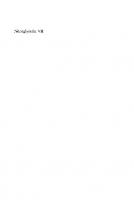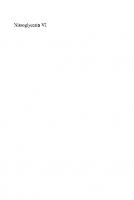Nitroglycerin 5: Fifth Hamburg Symposium 2nd November 1985 9783110898262, 9783110108798
172 100 9MB
German Pages 125 [128] Year 1987
Contents
List of contributors
Opening remarks
Current pharmacology of nitrates and calcium antagonists
Effects and modes of action of nitrates upon rhéologie properties of the blood and the supply to ischaemic tissue
Recent findings on the effect of nitroglycerin on haemorheology
Nitroglycerin therapy in operative medicine considering micro- and macrohaemodynamic aspects
Topical glyceryl trinitrate as adjunctive treatment in Raynaud's disease
Studies of glyceryl trinitrate application in gastroenterology
Regional ventricular function before and after sublingual nitroglycerin in patients with a recent myocardial infarction, during the subacute and chronic phase
Therapy of coronary heart disease with nitrates in combination with other antianginal agents
Nitrate tolerance
New results in the field of nitrate tolerance under nitroglycerin, ISDN and ISMN
Current results of nitroglycerin therapy
Presentation of the Nitrolingual prize, 1985
Supplement. Nitroglycerin prevents exercise induced regional myocardial dysfunction in dogs
Supplement. Prevention of diminished activity of glyceryl trinitrate by use of an aerosol
Supplement. Contrasting effects of Nitrolingual-Spray® at rest and after exercise induced angina post exercise on myocardial nutrient flow
Recommend Papers

- Author / Uploaded
- Bodo E. Strauer (editor)
File loading please wait...
Citation preview
Nitroglycerin 5
Nitroglycerin 5 Fifth Hamburg Symposium Edited by Bodo E. Strauer
W DE
G
Walter de Gruyter Berlin • New York 1987
Responsible for the scientific programme:
Prof. Dr. B. E. Strauer Division of Cardiology Department of Internal Medicine Lahnberge Clinic Philipps University of Marburg D-3550 Marburg/Lahn This book contains 53 illustrations and 9 tables. CIP-Kurztitelaufnahme
der Deutschen
Bibliothek
Nitroglycerin . . . / . . . Hamburg Symposium. - [Engl. Ausg.], - Berlin ; New York ; de Gruyter Dt. Ausg. unter demselben Titel NE: Hamburger Nitroglycerin-Symposium 5. 2nd November 1985. - 1987 ISBN 3-11-010879-8
Library of Congress Cataloging in Publication Data Hamburg Symposium (5th : 1987) Nitroglycerin 5. Includes bibliographies. 1. Nitroglycerin-Therapeutic use-Congresses. I. Strauer, B . E . (Bodo-Eckehard) II. Title. III. Title: Nitroglycerin 5. [DNLM: 1. Glyceryl Trinitrate-congresses. 2. Glyceryl TrinitrateTherapeutic use-congresses. W3 HA177 5th 1985n / QV 156 H199 1985n] RM666.N725H36 1985 615'.2711 86-24275 ISBN 0-89925-163-3 (U.S.) © Copyright 1987 by Walter de Gruyter & Co., Berlin 30. All rights reserved, including those of translation into foreign languages. No part of this book may be reproduced in any form - by fotoprint, microfilm, or any other means - nor translated into a machine language without written permission from the publisher. Typesetting and Printing: Buch- und Offsetdruckerei Wagner GmbH, Nördlingen. - Binding: Dieter Mikolai, Berlin. - Cover design: Rudolf Hübler. - Printed in Germany. The quotation of registered names, trade names, trade marks, etc. in this copy does not imply, even in the absence of a specific statement that such names are exempt from laws and regulations protecting trade marks, etc. and therefore free for general use.
Contents
B. E. Strauer Opening remarks
9
W. Klaus Current pharmacology of nitrates and calcium antagonists
11
A. M. Ehrly Effects and modes of action of nitrates upon rheologic properties of the blood and the supply to ischaemic tissue
23
E. Ernst, A. Matrai Recent findings on the effect of nitroglycerin on haemorheology
29
N. Franke Nitroglycerin therapy in operative medicine considering micro- and macrohaemodynamic aspects
37
A. G. Franks jr. Topical glyceryl trinitrate as adjunctive treatment in Raynaud's disease
. . . .
47
M. Staritz, K.-H. Meyer zum Büschenfelde Studies of glyceryl trinitrate application in gastroenterology
53
W.-D. Bussmann, H. Sievert, R. Geiß, F. D. Maul, M. Kaltenbach Regional ventricular function before and after sublingual nitroglycerin in patients with a recent myocardial infarction, during the subacute and chronic phase
65
M. Stauch Therapy of coronary heart disease with nitrates in combination with other antianginal agents
71
H. Just Nitrate tolerance
81
6
Contents
M. Tauchert, W. Jansen New results in the field of nitrate tolerance under nitrolgycerin, ISDN and ISMN
87
J.O.Parker Current results of nitroglycerin therapy
97
A. Boskamp Presentation of the Nitrolingual prize, 1985
99
Supplement W. Schneider, G. Krumpl, N. Mayer, G. Raberger Nitroglycerin prevents exercise induced regional myocardial dysfunction in dogs
103
K. K. Teo, J. H. Horgan Prevention of diminished activity of glyceryl trinitrate by use of an aerosol . . .
113
I. Hutton, A. C. Tweddel, I. McGhie, W. Martin Contrasting effects of Nitrolingual-Spray® at rest and after exercise induced angina post exercise on myocardial nutrient flow
115
List of contributors
Prof. Dr. W. D. Bussmann
Zentrum der Inneren Medizin Abteilung für Kardiologie Klinikum der Johann-Wolfgang-Goethe-Universität Frankfurt Theodor-Stern-Kai 7 D-6000 Frankfurt/Main 70
Prof. Dr. W. Ehrly
Zentrum der Inneren Medizin Abteilung Angiologie Klinikum der Johann-Wolfgang-Goethe-Universität Frankfurt Theodor-Stern-Kai 7 D-6000 Frankfurt/Main 70
Dr. E. Ernst
Klinik für physikal. Medizin der Ludwig-MaximiliansUniversität München Hämorheologisches Forschungslabor Ziemssenstr. 1 D-8000 München 2
Priv.-Doz. Dr. N. Fanke
Institut für Anästhesiologie der Ludwig-MaximiliansUniversität München Klinikum Großhadern Marchioninistr. 15 D-8000 München 70
Prof. Dr. A. G. Franks jr.
60 Gramercy Park North New York, NY 10010 USA
I. Hutton, M. D.
University Department of Medical Cardiology Royal Infirmary Glasgow, G31 2ER
Prof. Dr. H. J. Just
Abt. Innere Medizin III Klinikum der Albert-Ludwigs-Universität Freiburg Hugstetter Str. 55 D-7800 Freiburg/Breisgau
List of contributors
8
Prof. Dr. W. Klaus
Pharmakologisches Institut der Universität Köln Gleueler Str. 24 D-5000 Köln 41
Dr. J . O. Parker
Division of Cardiology Etherington Hall Queens University Kingston, Ontario Canada
Dr. W. Schneider
Pharmakologisches Institut der Universität Wien Währinger Str. 13 a A-1090 Wien
Dr. M. Staritz
I. Med. Klinik und Poliklinik Klinikum der Johann-Gutenberg Universität Mainz Langenbeckstr. 1 D-6000 Mainz
Prof. Dr. M. Stauch
Sektion Kardiologie, Angiologie, Pulmonologie Zentrum für Innere Medizin Universität Ulm Steinhövelstr. 9 D-7900 Ulm
Prof. Dr. M.Tauchert
Medizinische Klinik Stadtkrankenhaus Leverkusen Dhünnberg 60 D-5090 Leverkusen
K.K.Teo, M.D.
Department of Cardiology Saint Laurence's Hospital Dublin 7
Opening remarks
This workshop will deal with some more recent fields of nitroglycerin research. I am particularly happy that a number of foreign guests are present as well. This is why we are having simultaneous translation. I think this is the first time that participants from the United States, Canada and Great Britain have joined us for a nitro symposium. You know that nitroglycerin has a multifactorial effect and acts upon many organs, i.e. not just on the heart, the coronary vascular system, but on the smooth muscles generally. This complexity of nitroglycerin effects means that the programme presented today is also very complex and is broadly based. Because of the numerous nitroglycerin effects it comprises a number of medical disciplines, and this is why speakers from the fields of pharmacology, angiology, then anaesthesiology, dermatology, and finally internal medicine, in particular cardiology and gastroenterology, have been invited. Nitroglycerin has been available clinically for more than a hundred years - one is tempted to say on the market - a therapeutic evergreen, and it is surprising that new results are found even now. We shall see what opinions are expressed on this in the papers. The speakers whom we were able to win are Professor Klaus from Cologne, who is going to make a comparison of nitrates and calcium antagonists in his fundamental paper; then Professor Ehrly from Frankfurt, who is going to present his new and innovative findings in rheology; then the authors Dr. Ernst and Dr. Matrei from Munich continuing with the same subject; then Mr. Franke, a lecturer from Munich, who is an anaesthesiologist and who will focus on microcirculation of the heart, particularly under hypotension and surgical measures; then Professor Franks, a dermatologist from New York, who is going to present the effects of nitrate on the vascular system in conditions of vasospasm and vasculitis in Raynaud's disease; and Dr. Staritz from Mainz with a subject from the field of gastro-enterology under the effect of nitrates in gastro-enterologic indications. The afternoon will be devoted entirely to the heart. Professor Bussmann from Frankfurt will present his findings on nitroglycerin effects in acute myocardial infarction; Professor Stauch will report on monotherapy and combination therapy with nitrates, the possible combinations. And then there will be the subject of nitrate tolerance which has been hotly debated for years and that Professor Just from Freiburg and Professor Tauchert from Leverkusen will give us their views upon. Afterwards there will be a joint discussion.
10
Opening remarks
Ladies and gentlemen, I should like to open the symposium. I have introduced the speakers to you and now request Professor Klaus to start his fundamental paper on nitrates and calcium antagonists. B. E. Strauer
Current pharmacology of nitrates and calcium antagonists W. Klaus
Introduction The pharmacological basis of the therapeutic effects of organonitrates and calcium antagonists have been described in a number of papers before in such a comprehensive manner [e. g. 3, 10, 17] that, apart from a review of their fundamental mode of action, certain aspects only are to be selected for a more detailed presentation. Although the range of indications for these classes of drugs has been extended to a considerable degree recently, the treatment of coronary failure is still the traditional focus of therapeutic applications to which the following remarks will be confined.
Preliminary remarks on pathophysiology and therapeutic principles of coronary failure The classical form of exercise-induced angina, based on a fixed arteriosclerotic stenosis of an afferent epicardial coronary vessel, is characterised by the fact that due to impaired functional capacity of the heart muscle at the beginning of the exercise situation, end-diastolic pressure rises drastically and results in regional compression of the subendocardial vascular bed if the reduced poststenotic perfusion pressure is exceeded. The result is subendocardial ischaemia which becomes evident in the ECG as a typical ST-segment depression (fig. 1). As opposed to this, transmural ischaemias (with ST-segment elevation in the ECG) may form through obstruction of a stenotic vessel, for example, by aggregating thrombocytes or superposed vasospastic reactions. The basic therapeutic approaches (fig. 2) to a functional compensation of these regional disturbances of myocardial oxygen balance are: 1. to lower the overall oxygen demand of the heart by reducing internal and external cardiac performance as is possible by diminishing preload, afterload and heart rate, or 2. to improve poststenotic oxygen supply by eliminating or preventing vasospastic reactions through the interaction with thrombocytes [16] and/or a-adrenergic mechanisms [5]. (Perfusion pressure increases should only be considered in certain special cases). Nitroglycerin 5 © 1987 Walter de Gruyter & Co., Berlin • New York
12
W. Klaus exercise - Induced
angina
at
angina
rest
Fig. 1 Schematic representation of the different regional perfusion conditions and E C G changes in fixed and dynamic coronary stenoses.
Organonitrates and calcium antagonists are capable of influencing individual components to different extents; in principle, both groups of active substances are suitable for this therapeutic aim while their profiles of action have different points of emphasis.
Mode of action of organonitrates Organonitrates have a relaxant effect on vascular smooth muscles after undergoing intracellular biochemical activation to form a nitrosothiol with SH-group donor involvement (fig. 3). Via stimulation of guanylate cyclase, cGMP is increased;
13
Current pharmacology of nitrates and calcium antagonists Therapeutic
p r i n c i p l e s of a c t i o n in coronary failure
increase in myocardial 02-supply
reduction of myocardial 02 - deman d
i>
1>
reduction of c a r d i a c performance
improved coronary flow
elimination of v a s o s p a s m s
reduction of afterload
reduction of preload
thrombocyte stabilisation
i n c r e a s e in perfusion p r e s s u r e
r e d u c t i o n of h e a r t rate
Fig. 2 Therapeutic mode of action in medical treatment of coronary failure.
blood / e x t r a c e l l u l a r
GTN

![Nitroglycerin 8: Basics, Standard and Elective Applications. Eighth Hamburg Symposium [Reprint 2020 ed.]
9783110821284, 9783110149784](https://ebin.pub/img/200x200/nitroglycerin-8-basics-standard-and-elective-applications-eighth-hamburg-symposium-reprint-2020nbsped-9783110821284-9783110149784.jpg)
![Nitroglycerin V: Fünftes Hamburger Symposion 2. November 1985 [Reprint 2019 ed.]
9783110898255, 9783110108774](https://ebin.pub/img/200x200/nitroglycerin-v-fnftes-hamburger-symposion-2-november-1985-reprint-2019nbsped-9783110898255-9783110108774.jpg)
![Nitroglycerin 9: Nitrates and Mobility. 9th Hamburg Symposium [Dt. Ausg. u.d.T. Nitroglycerin IX. Reprint 2020 ed.]
9783110809176, 9783110167764](https://ebin.pub/img/200x200/nitroglycerin-9-nitrates-and-mobility-9th-hamburg-symposium-dt-ausg-udt-nitroglycerin-ix-reprint-2020nbsped-9783110809176-9783110167764.jpg)




![The Cambridge Ancient History, Vol. 5: The Fifth Century BC (Volume 5) [2nd Revised & enlarged]
052123347X, 9780521233477](https://ebin.pub/img/200x200/the-cambridge-ancient-history-vol-5-the-fifth-century-bc-volume-5-2nd-revised-amp-enlarged-052123347x-9780521233477.jpg)
